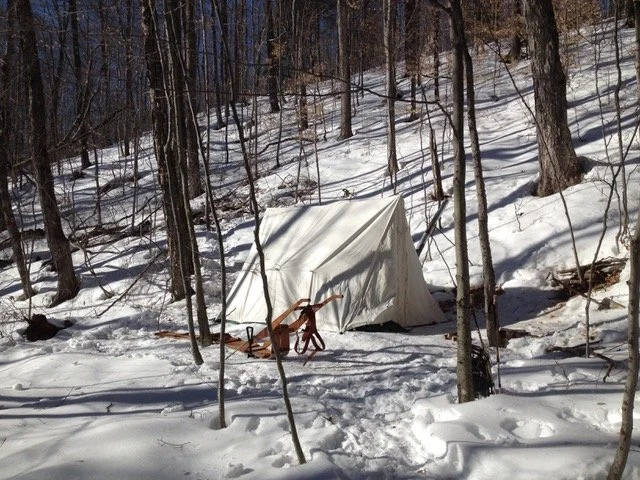A happy man. Photo courtesy of Sheldon Perry
Winter Camping—Really?
By Sheldon Perry
This piece first appeared in the Wonalancet Out Door Club newsletter in the fall of 2016. Read other winter camping stories from that issue HERE. Join us on February 12, 2022 for a Winter Camping Expo to see the tents and toboggans in person, and enjoy a bowl of soup around the campfire with neighbors. Details and register HERE.
“Summertime and the living is easy” is a well-known phrase. But what about winter? I have a counter phrase for this: “Summer gives you its love. In winter, you have to go out and earn it!” If you’re not out in the quiet cold of winter playing and enjoying the beautiful low-angle sunlight, winter becomes scraping the ice off your windshield and driving around on those dirty, salt-covered roads.
So, when a friend of mine, Geoffery Burke, showed me his 11-foot trekking toboggan, designed for hauling his winter gear, wanigan (a wooden chest for pots, skillets and kitchen supplies) and tent setup for a compact lightweight wood stove, I saw the light. This could be days and nights in the woods, in comfort! After many years of canoe camping, I have learned that the point is not to “rough” it but rather to “smooth” it while in the woods. After all, it’s rough enough in town.
To get started, I needed more information. The book A Snow Walker’s Companion by Garrett Conover and Alexandra Conover Bennett is the iconic winter trekker’s guide, absolutely stocked with detailed information about tents, stoves, toboggans, snowshoes, gear and food, as well as the preparation and the planning for extended trips. What a resource! In addition, if you want to rub elbows with extreme snow walkers, attend the Snow Walker’s Rendezvous at the Hulbert Outdoor Center in Fairlee, Vermont. This November event is awe-inspiring. While there, my friend Geoffery, a wooden boat builder by trade, teaches a toboggan building course, and I, being a wood nut, thought, “I can do this!” By the fall of 2014, there were just two missing ingredients—a tent and its accompanying wood stove.
Sheldon’s tent, set up deep in the woods. Photo: Sheldon Perry
Finding a tent was easy. Tentsmiths fabricates traditional canvas tents for folks via the internet and is just up the road in Conway, NH. I chose a Civil War era wedge tent, large enough to sleep three people, with gear, including the wood stove. The tent is both fire resistant and water repellant. They customized my tent with a five-inch flexible thimble for the stove flue. My wood stove came from Snowtrekker in Solon Springs, Wisconsin. The sheet metal stove, including the stovepipe, only weighs 17 pounds. A heat reflector and the cloth hearth are necessary to prevent snow from melting underneath. At this point, in my own mind at least, I am ready to go! It’s the fall of 2015 and snow is a-comin’!
Winter camping is a ton of work and hardly a solo endeavor. My vision is less about hauling and trekking and more about setting up a cozy base camp and taking day snowshoe trips from there. For my campsite, the White Mountains offer a plethora of choices, but I look for the following: Access should be on a moderately graded trail to a site deep enough in the woods to feel that I am away from the hubbub of civilization, yet close enough such that I will not drop dead getting there while hauling my loaded toboggan. There should be clear running water nearby and an assortment of interesting day hikes to keep me busy during a good portion of any day. Any site should be 200 feet from both a trail and any source of water. But keeping busy is not a problem. There is much to do in setting everything up. This is where company is really handy.
Inside the tent, with cosy rugs! Photo: Sheldon Perry
At this point, you have arrived with your trekking toboggan, loaded with all the gear (wanigan, food, clothing, sleeping bag, mat, and at least one luxury item (your choice). The first move is to pack down the snow with a generous area for the tent. This should be slightly crowned such that any moisture will drain away from the site. Set up the tent on a large water repellant tarp. I set my stove on thin Baltic plywood for stability and securely fasten the stovepipe with a tripod structure and wire. Allow for the wind! Rugs are a must, of course. Another person should be looking for dry (key word—dry) firewood situated nearby. Downed hardwood trees with branches up off the ground are ideal. Undersize the wood to fit comfortably within the stove and expect to feed it often. Crosscut with a bow saw and, when necessary, competently split to size with an axe. I like to sort and stack the wood according to diameter both within and outside the tent. It’s a lot of work, but you will feel great doing this knowing the reward will be a well-heated tent. If everything goes smoothly, you should do all this work and have a hot cup of tea (or glühwein) warming your hands within a generous hour. That is the goal!
Inside the tent, with the stovetop in good use. Photo: Sheldon Perry
Remind yourself that the farther you are out into the woods and the nastier the weather, the better any meal will taste. Cooking is done on top of the stove. An accessory metal shelf that extends the stovetop area is well advised, as this will allow for more pots and the ability to simmer. Always have a large teapot full of hot water ready for drinks and cleaning up. Bring hors d’oeuvres. Live it up! Oh, did I mention that you don’t even have to think about bugs or bears?
By now you are thinking about elimination, you know, the solid kind. No magic wand here. Dig (beyond the snow and into the earth, the deeper the better), squat, and replace your divots. I always have sanitizing hand wipes, in abundance, because clean hands are way more than just a courtesy.
Ok, my first four-night stay went amazingly well for a neophyte. My guests were also on their first winter camp trip, but they were the best at just about everything. Having a love for the outdoors in winter will make it work. But I did learn a few things: My long trekking toboggan, although great for the tundra of the far north, did not work well on a White Mountain forested trail. It would rather tip over than take a turn, and, as I pulled it with a strap, I could not control the front end. Going downhill, I shifted positions to tether it from the rear—not very convenient.
Sheldon with his tractor trailer toboggan. Photo courtesy of Sheldon Perry
Accordingly, I made several significant adjustments, which included cutting my toboggan in half to create a tractor (the front half) and a trailer (the rear half) and then used some quick-releasing marine hardware to hinge them together. I devised a rigid yoke to connect me to the tractor and a leather harness to connect me to the yoke. Yes, I am both the engine and brakes. With these three detachable elements, many advantages appear. I can fit everything in my car—nice. I can take sharp turns on the trail and, if I come to a steep section, I can detach the trailer, proceed up with just the tractor and return with a strap to haul the trailer. Brook crossings or other obstacles are less problematic, as my load is divided into several units. One last important note: each guest needs a sled to haul his or her own gear, even if it is plastic.
Even in winter, I ditch the phone (or turn it off) and leave the world as I know it behind. Everyone needs a break from the day-to-day routine. And where better to enjoy (and employ) all those outdoor skills? On a winter mountain adventure.
Banner image: A winter tent set up deep in the snowy woods. Photo: Sheldon Perry


